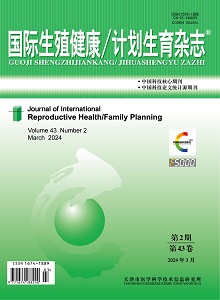Objective: To visually analyze the prediction model of early-onset preeclampsia based on the knowledge map drawn by CiteSpace software. Methods: CNKI, Wanfang, VIP, PubMed and Web of Science (WoS) databases from January 1st, 2004 to December 31st, 2023, were searched on the relevant research on the prediction model of early-onset preeclampsia. CiteSpace software was used to visually analyze the authors, institutions and keywords of the literature. Logarithmic likelihood rate (LLR) clustering is used to perform cluster analysis on Chinese and English data keywords. Results: A total of 693 articles were included, including 327 articles in Chinese and 366 in English. The number of published studies on the prediction of early-onset preeclampsia at home and abroad was generally on the rise. The cooperation between authors and institutions of the English literature database was relatively close, while the cooperation between authors and institutions of the Chinese literature database was relatively scattered. Two clusters were obtained from Chinese literatures, which were early onset and prediction. Seven clusters were obtained from English literatures. which were DNA methylation, early pregnancy screening, early onset preeclampsia, oxidative stress, multiple immunoassay, fetal body mass estimation and HELLP syndrome. The outburst word analysis showed that the Chinese literature database mainly focused on the analysis of clinical characteristics and treatment strategies of early-onset preeclampsia in 2019 and before, and focused on the construction of prediction models using traditional markers of eclampsia in 2020 and after. The English literature database mainly focused on the independent risk factors of early-onset preeclampsia, not only including maternal factors (history of onset preeclampsia, gestational hypertension, fetal growth restriction, etc.), traditional markers (uterine artery Doppler ultrasound, biochemical markers, vascular growth factor, placental growth factor, etc.) and other clinically reliable and practical specific indicators, but also using some specific indicators of immunity, DNA methylation, oxidative stress that could be widely used in future clinical practice. In this paper, a model was built for predicting the occurrence of early-onset preeclampsia, based on the traditional statistical methods and innovative integration of machine learning algorithms. Conclusions: At present, the construction of predictive models for the onset of early-onset preeclampsia is still a research hotspot at home and abroad. To discover the specific indicators will further enhance the reliability of the predictive models constructed under the background of fusion machine learning algorithms.

